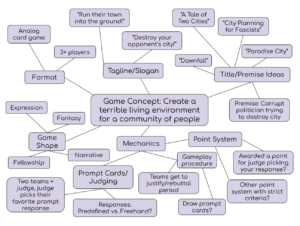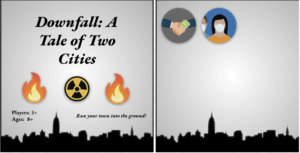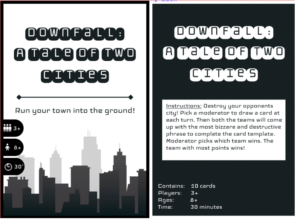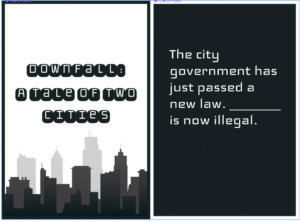Artist’s Statement:
The intent of our project is to create an elegantly simple, fun, and humorous social game that can be played by almost any audience. The elegance of our game is immediately communicated through our visual branding which consists of a minimalistic design and monochrome color scheme. As for the gameplay, we drew inspiration from city-building games such as Sim City and card-based party games such as Cards Against Humanity and Quiplash which served as key models for the conceptualization of our game. We wanted to combine the simplicity of the card games with the imaginative aspects of SimCity into a single balanced game that was easy to understand yet able to spark creativity. Also, instead of asking players to build the best possible city, we asked players to instead build the worst possible city. We believe that this twist adds to the engagement and humor of our base idea and makes our game a novel experience for players. Ultimately, we hope that from playing our game, people will exercise creativity, bond with others, and enjoy many laughs.
Concept Map:

Formal Elements:
Our game’s shape takes on the spokes of fantasy, fellowship, expression, and narrative. In short, we see players exercising an expression of fantasy by constructing quick, imaginary narratives that can be done with others (in teams). With regard to formal elements, the main objective of the players is to accumulate enough points through the action of constructing winning responses to card prompts. The procedures are then advanced by the judge (moderator) who progresses the game by drawing cards and awarding points. During each round, players have a limited amount of time to answer and the primary scarce resource (besides imagination) thus becomes time. Lastly, players/teams work in isolation to respond to the prompts but ultimately face head on in a competitive (but loosely competitive) manner to out-do each other. The subjectivity of the judge opens up the gray areas of the games and makes the dynamic more unpredictable.
Testing and Iteration History:
Overall, our game went through several iterations of refining, addition, and removal. In the first brainstorm of our game, we went through the process of figuring out all of the different directions we could take our base idea. We started with the broad conceptualization of a Sim City meets Cards Against Humanity hybrid but with the twist of players needing to design a “bad” city instead of a good one. However, in the process of trying to flesh out the details, there were a few choices that we had to make throughout this process.
- Pre-Testing Game Development:
The first was deciding whether we wanted an objective point system or a judge to define the score. When we first started thinking about the mechanics, we thought about a rough mechanism with predefined cards where certain cards held specific point values. We quickly realized that this approach would become unnecessarily convoluted and instead decided on a subjective judge who we thought would make the game more interactive, more personal, and simply more fun. We specifically referred to the mechanics of Quiplash and noticed its subjectivity as one of the core mechanisms driving the effectiveness of the game. This leads to the next decision which was the choice between using freehand responses and pre-defined answer cards. The initial vision was to use predefined cards in line with games such as Cards Against Humanity but it immediately felt too limiting for the dynamic we wanted to cultivate. In attempting to come up with a list of predefined answers, we realized that we could not adequately cover the scope of possible answers and felt constrained by its limitations. Instead, freehand responses allowed for more creativity, more personal answers such as inside jokes, and quickened the pace of the game (don’t have to draw answer cards). In our critical plays for related games (Quiplash), we realized that the ability to express inside-information among a group of people familiar with each other drove a lot of enjoyment for those games.
As for the playtests, we had 5 playtests in total, and over these playtests, we had 3 major iterations where we added several key improvements.
- Iteration 1 (12th April) + Iteration 2 (14th April):
One of the major changes resulting from both our playtests during week 3 was having players answer a single card prompt instead of their own card prompt. At first, we had players each draw their own card which they would then answer on their own. However, it led to an imbalanced dynamic which made it more difficult and less enjoyable for the judge to pick their favored answer. Once we did change this mechanic to having players answer only one card, the game instantly became more straightforward and more pleasant to play. The next major change was the insertion of a rebuttal period for players. Although it might have been more “unbiased” for players to simply read out their answers, we realized that much of the enjoyment of our game was having players and the judge be able to deliberate on the answers to allow players to express their creativity in coming up with unique explanations for their answers. We drew particular inspiration from the monster battle activity in class and noticed the extreme satisfaction that people found in being able to verbally communicate creative justifications for their cards. Finally, the other core change resulting from the playtests was the distinction of players destroying their own city instead of the other team’s city. During our playtests, one of the recurring questions we received was whether they were destroying their own city or destroying the other player’s city. We realized that we needed to provide more explicit information about this fact and came to the decision that players were to destroy their own city which we backed up with our visual material and slogan.
- Iteration 3 (19th April):
By this point, we had most of the major details right, however, we still needed to fix smaller details to further refine our game and the experience as a whole. From our playtests, we determined that playing to a best of 5 was a decent length for the game and didn’t feel too long or too short. Considering that our cards didn’t adhere to any specific themes, there was enough room to see a variety of different prompts but not too many where the game felt dragged on for too long. Next, we included the addition of a timer which set explicit boundaries on the actions of the players. This design decision came quickly after our first playtest in which we observed some players taking an extremely long time to answer which we saw as a possible blocker for a smooth pacing of the game. Instead, we added a time constraint which we felt added to the “excitement” of the game since it encouraged players to act quickly (and simply sped things along quicker). Lastly, we were able to build a more fleshed out physical model of our game from our playtests such as making custom two-sided cards prompts and interactive objects for determining score.
- Thoughts and Conclusions:
However, there were some conflicting questions and considerations that we weren’t able to completely resolve during the testing process. First, we wondered about adding a “twist” to the game that somehow raised the stakes. One worry was that the excitement of the game might quickly wear off with the uniformity of the rounds, and that some way to increase the stakes would improve engagement. However, this was mitigated by the fact that our games are relatively short and that people in our playtests seemed engaged the whole way through regardless. In a future iteration, we would certainly figure out a way to inject more “excitement” within the game such as special or higher weighted cards. Some other considerations that did not make the final cut were rotating the judge during the game (although again, this was resolved by the fact that our games are short) and including multiple themes within our game. In the initial stages of our game, we thought for a while about possibly incorporating themes into our games such as different settings (ex: Apocalypse vs Normal City), worlds (ex: Supernatural or Star Wars), or even the nature of the cards (ex: Newspaper Headlines). We additionally entertained the idea of switching themes each round but ultimately but never got a satisfying point for a workable implementation. This is another feature that we would certainly try to introduce in future iterations given more time.
Final Prototype:
- Game Details:
-
- Format: Analog Card Game
- Number of Players: 3+
- Recommended Ages: 8+
- Play Duration: ~15 min-1 hr
- Materials: Pen/Pencil, Paper (Sticky Notes), Paper Blocks
- Required Tasks: Writing / Speaking / Communication of any form (as long as it’s clear)
- Story:
Hello Mayor! This isn’t any ordinary city building game. We’re not in some altruistic world where the world is beautiful and people are great. No. You’re a corrupt politician who wants one thing: money. And as part of some cruel business plan, a business mogul has offered you a billion dollars to destroy your city. Seems like a good deal right? Well, not so fast. Turns out, they’ve extended the same offer to your rival city. And whoever designs the worst possible city gains the prize. So…do you have what it takes to run your town into the ground?
- Roles:
Players: Players can either play individually or in teams as long as the teams are relatively balanced (and that there is room for at least one judge). Players are responsible for filling in blanks to card prompts and justifying their answers during a rebuttal period.
Judge: The judge is responsible for drawing the card at the start of each round and starting the timer for the players. At the end of each round, the judge will listen to the answers of the players and award a point to whoever they think has the “worst” answer.
- Instructions:
-
- Split the group up into balanced teams and designate one person as the judge.
- Each team should have a pencil as well as a set of three blocks that they will stack next to each other.
- As part of the setup, have each team write down the name of their city and provide a short description of their city’s characteristics.
- Shuffle the deck of cards face down.
- The judge will draw a card from the top of the deck and read the prompt out to the players.
- The judge should start a 30 second timer afterwards.
- Then, players will take the allotted time to write down an answer to the prompt that they think leads to the “worst” possible city.
- After the time is up, each team will read aloud their answers. Each team can provide justification for their answers or provide rebuttals against other players at this point.
- The judge finally chooses the team that provided the “worst” answer and awards them a point.
- The team that receives a point can knock over the block that is on the top of their stack.
- Repeat this process until one team reaches three points or all of their blocks are knocked over (in which they win).
- Link to Game Cards:
https://drive.google.com/file/d/1PXBWzUDzXs8wJ_MRZAiOeY-0mAcug3Ir/view
- Link to Playtest Video:
Design Mockups:
- Front/Back Covers:
- First Iteration:

- First Iteration:
-
- Second Iteration:

- Second Iteration:
-
- Third Iteration:

- Third Iteration:
- Cards:
- First Iteration:

- First Iteration:
-
- Second Iteration:

- Second Iteration:


